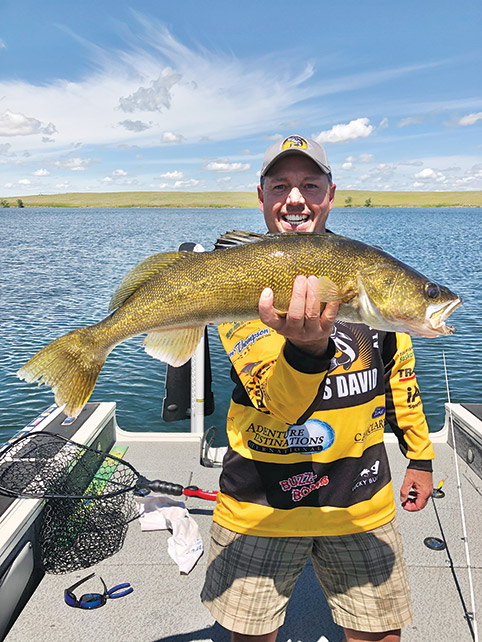 Fish & Tackle: Walleye Baits
Fish & Tackle: Walleye Baits
By Wes David
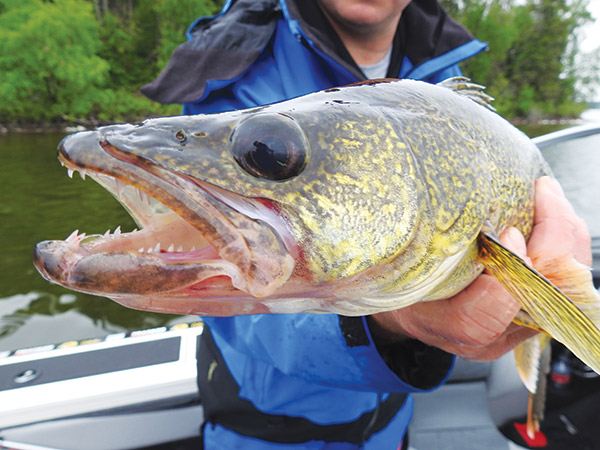
Fishermen are always looking to increase the catch, and for walleye anglers all across North America, live bait is the ultimate confidence builder. The walleye’s keen senses can detect miniscule amounts of scent in the water, and natural baits give off scents that trigger walleyes. The natural appearance of live or a fresh dead bait can seal the deal.
Minnows and bigger baitfish are the No. 1 walleye forage in most waters, and a lively minnow, where allowed, can be the most natural presentation. However, many states and Canadian provinces no longer allow live minnows for a variety of reasons, and where such restrictions are in place, we find ways to make frozen minnows look and act as naturally as possible. Jigging a fresh-frozen minnow can be as effective as jigging a live one.
But some jigs and jigging techniques are more effective than others. If you fish for walleyes with jigged minnows, I’m sure you have felt the weight on the line that tells you a walleye has taken the bait, set the hook but missed the fish. When you reel in, you may find half a minnow still on the hook. That walleye “bit short” and missed the hook. That happens most often because the hook shank was too short or the minnow was hooked short, allowing the fish to get most of it in its mouth without taking the hook.
To increase walleye hookups, use a jig with a long-shanked hook. The longer shank allows the hook to reach farther down the body of the minnow, and there are many ways to rig a minnow on a long-shank hook. My favorite is to run the hook through the eyes of the minnow, then give the jig a half turn and slide the hook down the outside of the minnow’s body and then bring it back through the body about a quarter or halfway down. If you do this, always check to be sure the hook point is exposed on the other side of the body.
A hook protruding from farther down the minnow greatly increases the odds of the point being in the walleye’s mouth when you set the hook. When you set the hook and feel the weight of the walleye, the most important thing from that point on is to not give the walleye any slack line. Slack line at any point in the fight increases the odds of the hook pulling out or shaking free, something fishermen colorfully if incorrectly describe as a fish “spitting the hook.”
A stinger hook is another way to increase hookups on short-striking walleyes. But do check all applicable regulations before fishing with a stinger hook. Some jurisdictions restrict it.
A stinger is simply a small treble hook on a very short length of monofilament line with a clasp of some kind at the other end of the line that can be hooked in the same eyelet where the main line or leader attaches to the eye of the jig. Some jigs come with a second eyelet specifically to accommodate a stinger hook.
A stinger hook may be impaled even farther down the body of the minnow, adding to the effective hook-setting length of the presentation. When a walleye bites short and misses the jig hook, the stinger hook may already be well in its mouth.
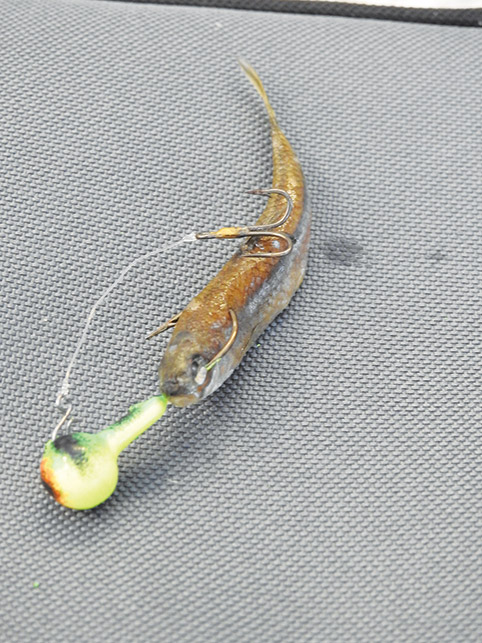
When rigging a minnow on a jig with a stinger hook, I still push the main hook through the eyes and back into the body, as described above. But then, as far down as the stinger hook will reach, I poke one of the tiny treble points into the body of the minnow close to the tail. Be sure the other hook points are facing up, to avoid snagging bottom. In most cases, a walleye takes the minnow as you’re lifting it within the cadence of a preferred jigging sequence. Even a short-striking walleye will have a stinger in its mouth, and when you lift the hook almost sets itself.
Stinger hooks are great for short-striking walleyes whether you are fishing frozen minnows, live night crawlers, or even soft plastics. But they are less than ideal when fishing a leech. A leech impaled on the main jig hook with a stinger further down its body tends to roll up into a ball that doesn’t look anything like a naturally swimming leach. The stinger can decrease bites more than it helps with the short strikes. With a leech, a jig with a short-shank hook is actually best.
If you just grab a leech out of the tub, hook it through one end and send it down, you’re probably going to catch something because walleyes key on leeches wherever they are found. However, you can greatly increase the hookups by understanding the anatomy of a leech and how it swims through the water.
A leech has a sucker at each end of its body. The head end is narrower and has a smaller sucker. When they swim, they swim headfirst. The tail end is flatter and has a larger sucker.
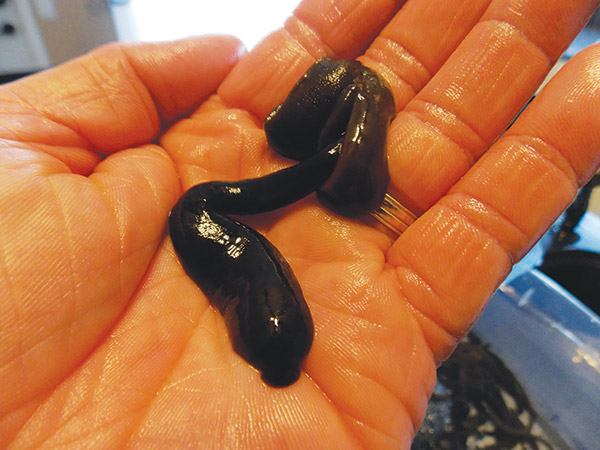
If you hook a leech through the head-end, drop the jig down and lift it just off bottom, the leech will flutter its tail. No doubt that action will attract walleye, and you will probably catch some of them.
However, if you stick the hook of the jig through the tip of the leech’s tail, drop the jig down and lift it just off bottom, the head will be free, and the leach will try to swim. Struggling with the jig will cause it to dart and dive. That erratic action is a natural trigger, something walleyes are used to seeing when prey tries to get away. It can trigger a walleye to strike regardless of whether it is feeding or not. Even a neutral walleye will take an easy meal pretty much whenever it can.
Simply hooking leeches through the tail and not the head can increase bites threefold. I am not just saying this. We have done the side-by-side comparison many times. The next time you’re fishing leeches with a buddy in the boat, hook his leeches through the head and yours through the tail, leaving the head free to swim. Try not to giggle as you out-fish him, and be sure to ’fess up so he can get into more fish, too.
Bottom-bouncing or Lindy rigging is a good way to cover more water and find active walleyes. Whether bottom-bouncing or lindy rigging, my go-to bait is a leech hooked the same way as described above. With a bottom-bouncer, the blade gives off flashes and vibration that can attract and trigger walleyes.
Bottom-bouncing also works with frozen minnows, and I’ve had the greatest success with leeches and frozen minnows using a No. 2 Mustad Slow Death hook. The bends in the Slow Death impart a corkscrew action as the bait is pulled through the water, and that gives off additional flash and vibration to attract walleyes and also trigger reaction strikes from fish that may not be in a feeding mood. Again, struggling prey is hard for any walleye to resist.
Bottom-bouncers and Lindy rigs also work well with a night crawler. But due to the length of the crawler, it’s common for a walleye to nip off the end or pull the crawler off the hook. Now you’re just feeding fish instead of catching them.
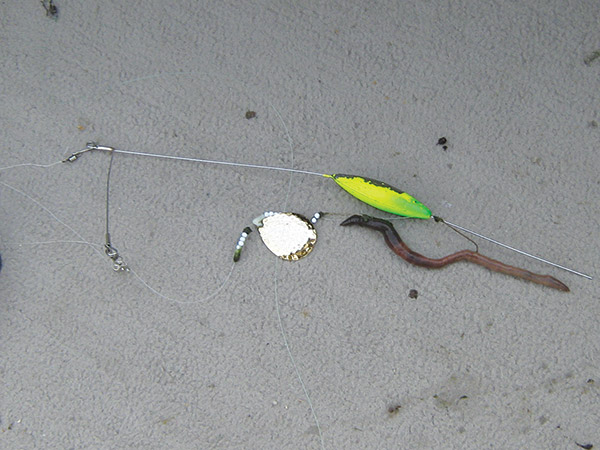
When bottom-bouncing a night crawler, I like a standard two-hook worm harness with a top J-hook about 2 inches from a bottom J-hook. You don’t need or want a Slow Death hook for this.
The two-hook harness best accommodates the length of a night crawler, and 90-percent of the time when a walleye bites, it will be caught by the trailing hook.
A full night crawler will greatly outfish the bits and pieces some anglers impale on hooks.
Don’t waste a good walleye bite trying to save or reuse bait.
Boat speed is another key consideration when it comes to bottom-bouncing any bait, and there is no one best speed. However, I like to move just fast enough that the weight of the bouncer is hitting bottom every foot or two, keeping the presentation down in the strike zone. Depending on wind or waves, I vary the boat speed to keep that bottom-bouncer making this contact every 1 to 2 feet. Moving with the wind, against the wind or across the wind all vary the speed, and current can vary the relative speed of a boat and a bait down below. The walleye will let you know when you get it right.
I use a 2-ounce weight most often, and I try to achieve and then maintain the desired bottom contact by adjusting boat speed. When needed, I also vary the weight to better match conditions.
I rarely pull a bottom-bouncer in a straight line. If you do, the bottom-bouncer blade and bait fall into a steady cadence that may work, but I’ve found steering the boat in a wide zigzag pattern works better, slowing the presentation on the inside turns and speeding the presentation on the outside turns. Every time the speed changes, the blade and bait give off a different flash, vibration, and an erratic action that triggers bites.
Live or frozen, it’s important to keep bait fresh. At the end of the day, drain the water from a frozen minnow tub, pat the minnows dry with paper towel and coat with pickling salt before placing them back in the tub in the freezer. This keeps minnows firm and fresh.
I keep live leeches in a large plastic container in the fridge, and I change the water in that tub every week.
Regardless of the unsavory blood-sucker reputation and association with stagnant water, leeches thrive in fresh water and also like to keep themselves clean. For this reason, I place two household steel-wool pads in the container. Leeches rub against these to clean dead skin off their bodies. Leeches don’t do well in chemically treated tap water. They live longer and stay healthier if you keep them in clean creek water or distilled water.
Healthier leeches, juicier night crawlers, and lively looking frozen minnows all increase walleye hookups.
Man-made scents can help trip the trigger, and for this I like Liquid Mayhem. It is used mostly by bass anglers to juice up soft plastics and other artificial baits. But it also sticks to live or frozen baits and is made from natural ingredients. The combination of more than one natural scent seems to trigger more bites for me, enough that I use the stuff more often than not. Big Sky Jigs makes a variety of specialty jigs for walleyes, all designed to improve a specific presentation.
